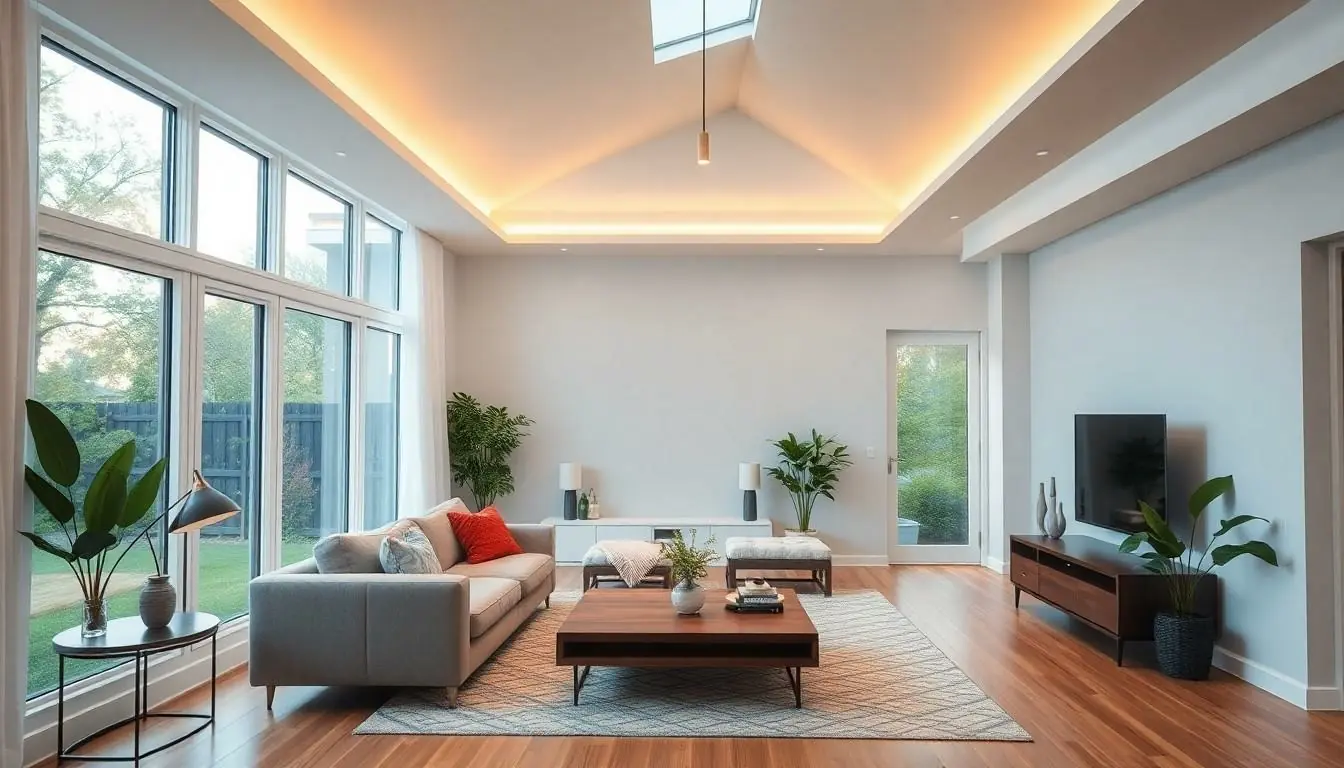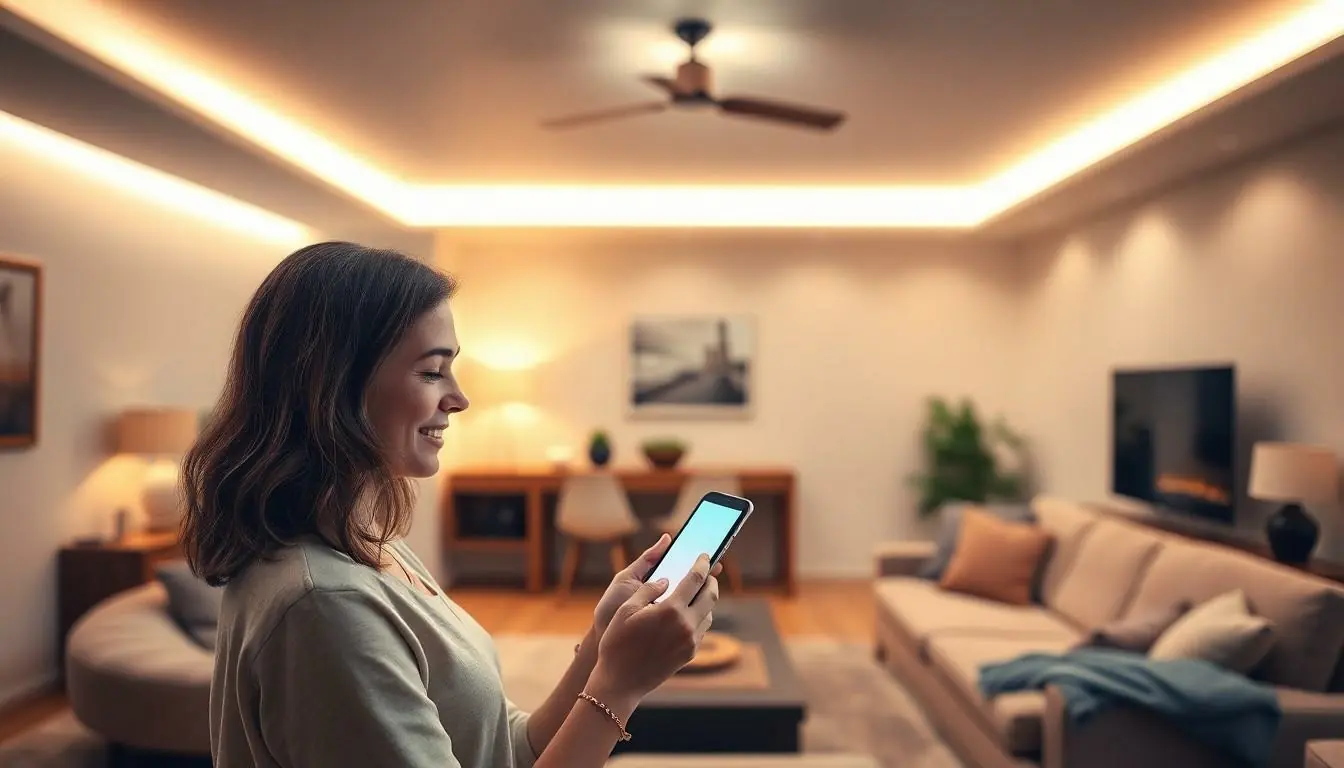Table of Contents
ToggleImagine walking into your home and having the lights adjust to your mood without you lifting a finger. That’s the magic of an adaptive lighting home assistant. It’s like having a personal lighting designer who knows exactly how to brighten your day—or dim it down for those Netflix binge-watching marathons.
Overview Of Adaptive Lighting Home Assistant
Adaptive lighting home assistants offer significant benefits for home environments. These systems intelligently adjust brightness and color based on various factors, including time of day and individual preferences. They enhance overall well-being by aligning lighting with circadian rhythms.
Users can experience increased productivity with brighter lights during work hours. Dimming lights in the evening promotes relaxation and prepares users for restful sleep. Many adaptive lighting systems utilize sensors to detect natural light levels, adjusting indoor lighting to maintain a balanced atmosphere throughout the day.
Integration with smart home ecosystems adds convenience. Homeowners can control adaptive lighting through voice commands or smartphone apps. This technology also allows for pre-set lighting scenes tailored to specific activities, such as reading or entertaining.
Moreover, energy efficiency plays a vital role in adaptive lighting home assistants. By optimizing light usage, these systems reduce electricity consumption, leading to lower utility bills. Combining functionality with sustainability addresses modern energy challenges.
Various brands and platforms, such as Philips Hue and Lutron, provide advanced solutions for adaptive lighting. Each offers unique features that enhance user experience and customization. Homeowners should carefully assess their needs to choose the most suitable system.
Overall, adaptive lighting home assistants transform living spaces. They foster optimal environments for activities while promoting wellness. Leveraging technology for improved lighting benefits enhances daily living and home aesthetics.
Benefits Of Adaptive Lighting

Adaptive lighting systems significantly enhance the living environment, offering multiple advantages that improve daily routines and energy consumption.
Improved Mood And Productivity
Brighter lights during work hours boost productivity and enhance concentration. Natural light simulates a more invigorating atmosphere, helping individuals stay alert. Additionally, dimmer lighting during leisure activities promotes relaxation and reduces stress. Users notice an improvement in their mood as lighting adjusts to their preferences and time of day. With personalized settings, individuals can create an ideal ambiance for various tasks. This tailored approach aligns with natural circadian rhythms, contributing to overall well-being.
Energy Efficiency
Adaptive lighting systems optimize energy usage across different situations, leading to reduced utility bills. Advanced sensors detect natural light levels, adjusting artificial lighting accordingly. By minimizing unnecessary illumination, these systems ensure that energy is used when and where it’s needed. Homeowners can program schedules that align with their routines, maximizing efficiency. Smart lighting technologies, such as LEDs, consume less energy compared to traditional bulbs. Overall, embracing adaptive lighting results in lower environmental impact while maintaining optimal home ambiance.
Key Features To Look For
When selecting an adaptive lighting home assistant, consider features that enhance functionality and ease of use. Two crucial elements include smart sensing technology and customization options.
Smart Sensing Technology
Smart sensing technology detects natural light levels and adjusts indoor lighting accordingly. These systems monitor brightness throughout the day, ensuring optimal illumination for various activities. With sensors in place, the assistant automatically dims or brightens lights based on available sunlight. For instance, brighter lights activate during cloudy days, while dimmed settings prevail during sunny afternoons. Such responsiveness enhances comfort and reduces energy consumption simultaneously. Adaptive lighting systems also consider user movement within a space, ensuring lights are always set to the appropriate level, contributing to overall well-being and efficiency.
Customization Options
Customization options significantly enhance user experience with adaptive lighting systems. Flexible settings allow individuals to create unique lighting scenes tailored to specific activities. For example, a “movie night” scene may feature soft, warm lighting, while a “working” scene focuses on bright, cool tones. Homeowners can program schedules that align with their daily routines, promoting convenience and simplicity. Additionally, some systems offer voice control capabilities, enabling effortless adjustments through smart speakers. Personalized settings not only cater to individual preferences but also facilitate an enjoyable atmosphere, enhancing the overall living experience.
Popular Adaptive Lighting Home Assistant Solutions
Numerous adaptive lighting home assistant solutions exist, offering homeowners versatility and advanced features. Philips Hue remains a top choice, known for its robust ecosystem and compatibility with smart devices. Integration includes voice control and a wide array of customizable lighting options.
Lutron Caséta also stands out, providing easy control of dimmers and shades. This system allows users to create specific lighting scenes tailored to their preferences. Smart sensing technology adjusts the lighting based on natural daylight, enhancing comfort and energy efficiency.
Wyze Bulbs attract budget-conscious consumers. Affordable options do not sacrifice quality, providing smart home integration and remote adjustments. Users benefit from simple installation and easy app control.
Nanoleaf specializes in artistic lighting designs. Unique shapes and customizable colors let users express creativity in their spaces. This brand offers integration with popular smart home platforms, enhancing its functionality.
Another popular solution is Google Nest. This assistant utilizes voice commands to adjust lighting and provides scheduled automations. Integration with other Google devices makes it a seamless choice for a smart home ecosystem.
Apple HomeKit appeals to users seeking a secure, user-friendly experience. The ecosystem provides strict privacy controls while allowing convenient control over various lighting options.
All these solutions enable homeowners to enhance their environments through smart lighting, improving mood, productivity, and energy efficiency. When selecting a system, consider features such as compatibility, ease of use, and customization options to find the perfect fit.
Adaptive lighting home assistants represent a significant advancement in home automation. By aligning lighting with personal preferences and daily routines they create environments that enhance mood and productivity. This technology not only promotes well-being but also offers energy efficiency benefits that can lead to lower utility bills.
With a variety of brands and features available homeowners can easily find a solution that fits their needs. Whether through smart sensing technology or customizable settings these systems make it simple to achieve the perfect ambiance for any occasion. Embracing adaptive lighting is a step toward a more comfortable and efficient home.



